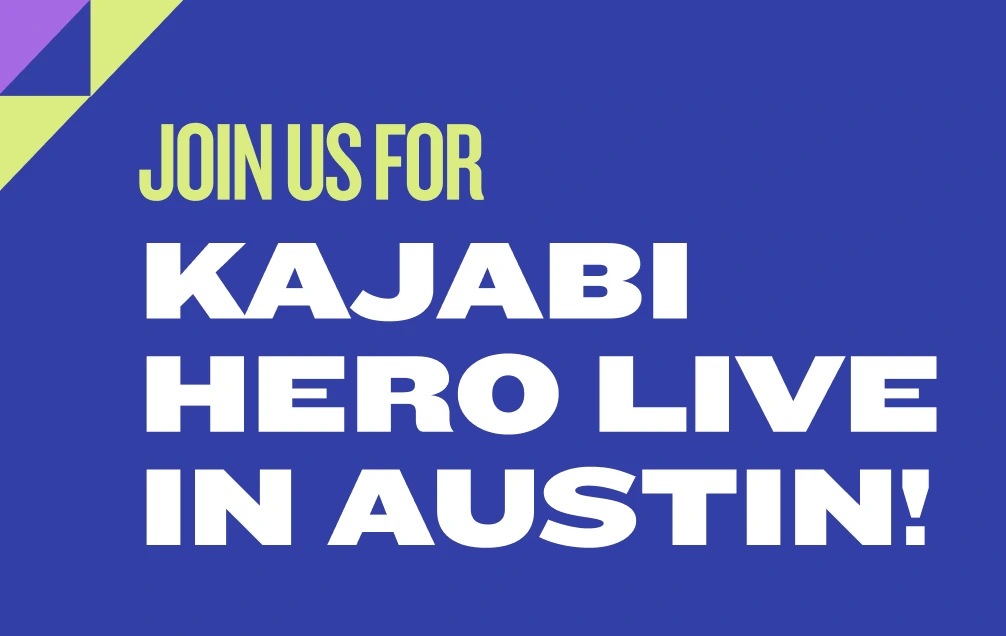
Marketing for Coaches: 17 Strategies for Success
Get free expert insights and tips to grow your knowledge business sent right to your inbox.
When you started your coaching business, it was likely because you wanted to help people. But what you may not have realized is that you’re also the face of your business. That means if you want to grow the business and get more clients, you have to get comfortable marketing yourself.
Many coaches and creators usually think that marketing feels too salesy or spammy. But it doesn’t have to be! The goal of marketing isn’t to sell and convince people to buy your product. The goal is to get in front of your target audience, provide value to them, and build relationships.
With that in mind, let’s go over a few different marketing strategies you can try to get more clients and grow your coaching business.
Marketing for Coaches: Your Key to Getting Coaching Clients
As a coach, you have a wealth of knowledge in your field. You have firsthand experience in your industry and you’re confident you can help your clients reach their goals and work through challenges.
But if those clients don’t know you exist, then you won’t be able to help them along their journeys.
This is why you need a marketing strategy. With a marketing strategy, you can:
- Reach your target audience
- Improve your brand awareness
- Establish yourself as an industry leader
- Build your network
- Grow your coaching business
Marketing for a coaching business entails getting in front of your target clients, demonstrating your credibility as a coach, providing them with valuable content, and building trust with your audience. While coaches often think of social media as the go-to place to promote themselves, an effective marketing strategy goes well beyond the confines of Instagram and LinkedIn.
When done right, your marketing efforts may only take a couple of hours out of your week. Once you have a solid strategy in place and you know which channels work well for you, you can automate a lot of the process.
How to Market Your Coaching Business: 17 Strategies to Try
If you’re wondering how to get more coaching clients, try integrating some of these marketing strategies into your coaching business.
1. Create a social media strategy
It’s no secret that social media is an effective channel for getting in front of your potential clients. Being active on social media can not only increase your brand awareness but also boost lead generation — as long as you’re using the right channels for your business.
According to the Social Media Examiner’s 2023 industry report, Facebook and LinkedIn drove the most leads for marketers out of all social channels.
To find marketing success on social media, you need a strategy. A social media strategy outlines who your audience is, which channels you should be on to reach that audience, and how you’re going to promote your services to engage that audience.
When deciding which social channels are best for marketing your coaching business, consider where your audience spends the most time and meet them where they are.
For example, if you’re a business coach who works with executives, your coaching business would likely benefit more from creating thought leadership content on LinkedIn. If you’re a coach for artists and creatives, focus on Pinterest and Instagram since those are more visual platforms.
Once you have a strategy in place, you can experiment with different content ideas and strategies.
2. Set up an email list
From algorithm changes to saturated feeds, sometimes social media can be tricky to reach clients. If you want a more direct way to promote your services, you need to set up an email list for your coaching business.
Email marketing is essential if you want to generate leads, build deeper relationships with prospective clients, and take a more targeted approach to marketing.
Setting up an email list involves collecting emails, segmenting those emails, and sending automated email funnels to warm up the relationship and eventually convert subscribers into customers.
3. Contribute thought leadership content
You’re an expert with a ton of coaching knowledge. One way to market that expertise and establish credibility is to share your knowledge with a wider audience. You can do this by contributing to blogs and media websites, either through guest posts or with quotes.
Through the Forbes Coaches Council, for example, members can publish thought leadership articles on Forbes.com. Since Forbes is an established and well-known website, sharing your expert insights there would position you as an industry leader.

You don’t need to be published in Forbes to be seen as credible. There are plenty of guest posting opportunities that can help build your reputation and get in front of your target audience. Look for websites and thought leaders within your industry, then see if they accept guest posts or have an active blog that you can contribute to.
If you don’t want to write articles, you can also contribute quotes as an expert source. Look at websites like HARO (Help a Reporter Out) to find opportunities from journalists looking for sources.
The benefit of contributing articles or even just quotes to other websites is that you typically receive a link back to your website.
This is called backlinking and it helps boost your website’s SEO by letting Google know that you are a credible website. Even better if you can get links on websites with high Domain Authority (DA).
4. Join Facebook Groups
More than 1.8 billion people use Facebook Groups each month, making them a great place to find coaching clients.
To make the most out of Facebook Groups, you have to be an active participant.
This doesn’t mean you should spam every conversation with a link to your contact form. But it does mean you should contribute to relevant conversations with valuable insights that demonstrate your knowledge and expertise. Doing this will organically showcase you as a credible coach that people would want to work with.
Don’t get us wrong, Facebook Groups are great, but there are potential downsides to the platform. For starters, they can get too big, making it challenging to navigate conversations or get your comments seen.
If you don’t want to join a Facebook Group, there are plenty of Facebook Group alternatives out there. You can also consider starting your own online community.
5. Offer free coaching calls
Think about the last time you were offered a free trial. It was nice to try out the product or service to figure out if you wanted to continue using it, right? In fact, it probably made it easier to commit to the full subscription.
This is the same feeling you can provide your coaching clients when you offer free coaching calls to prospects.
A free 30-minute consultation gives potential clients a glimpse at what working with you will be like. They can see what your coaching style is like, how your personality aligns with theirs, and maybe even get a quick tip or two they can use right away.
The benefit for you is that by offering free coaching calls, you establish trust and credibility right out of the gate. Clients can feel confident about working with you as a coach on an ongoing basis, which increases your client retention.
6. Create lead magnets
A lead magnet or lead generation tool is something you offer people in exchange for their email. Lead magnets are an example of top of funnel marketing (TOFU).
TOFU is a marketing strategy that focuses on brand awareness and lead generation. The goal with TOFU content is to attract potential clients and provide valuable content for them to engage with — the goal isn’t to get them to immediately sign up for your coaching services.
For example, if you’re an online fitness coach, you could create a 30-day calendar with one fitness tip for each day. Potential clients could download this lead magnet in exchange for their email.
Here’s another example of an effective lead magnet from Blaine Anderson, the coach behind Dating by Blaine. By signing up for her email list, subscribers automatically get four free dating guides.

By creating lead generation content, not only will you have their email to use for marketing funnels, but subscribers will also benefit from your free tips. This means they may be more likely to work with you as their coach once they see how helpful your tips were for them.
7. Launch a podcast
Starting your own podcast is a great way to share your expertise with the world.
A podcast can provide a preview of what your coaching style is like. You can share your coaching philosophy, speak on relevant industry trends, and even interview guests.
When thinking about podcast guests to bring on your show, consider people from different industries who may have similar audiences as you. This would help you get in front of potential clients you may not have otherwise.
If you’re not ready to launch a full-blown podcast into the world, start by looking for guest appearance opportunities to ease yourself into the podcasting world.
Another creative way to incorporate a podcast into your marketing strategy is to make a podcast for your membership community. This means your podcast would be for a smaller, private audience and your topics could address more niche topics that you know are important to your members.
8. Start a YouTube channel
Prefer to create face-to-face content? Start a YouTube channel to promote your coaching business.
If you need more convincing that YouTube is a smart channel to be on, data from Statista shows that YouTube is the second most popular social media platform worldwide after Facebook.
Similar to a podcast, you can also bring guests into your videos to double your audience size. The key to collaborating with others for your marketing is to find common ground. Even if you come from different industries or backgrounds, each of you should benefit from reaching a new audience and driving organic traffic.
9. Boost your SEO
We’ve touched on several digital marketing channels and trends so far, but the one thing that will remain a constant fixture in your coaching business is your website.
To make sure your website is always positioned to reach your target clients, your site’s SEO needs to be regularly updated and maintained.
There are a few elements to keep an eye on if you want to improve your SEO:
- On-page SEO: This is the copy on your website, from your page titles to the meta description to your body copy. Make sure you have a few target keywords incorporated across your site. For example, if you’re a business coach for freelance writers, that keyword should be your homepage title so anyone searching for that can find you.
- Content marketing: If you have blog posts on your website, make sure they’re optimized for search. This means selecting a few target keywords you can write about and weaving those into your relevant blog posts so they show up in the search results.
- Backlinks: As mentioned earlier, securing backlinks to your website can help generate organic traffic and boost your website’s search ranking. You can get backlinks by contributing guest posts to other websites or getting quoted and mentioned in articles.
10. Optimize your landing pages
A major element of any marketing campaign is the landing page. Whether you’ve created a lead magnet or you’re promoting a new service, make sure your website landing pages are designed well so you can get the most out of them.
Your landing page should include compelling copy and a strong CTA (call-to-action), outline clear benefits the potential customer will receive, and showcase results other people have achieved after using your offering.
Here’s an example of a strong landing page for Justin Welsh’s content course, Content OS. To promote the course, Justin outlines the learning benefits, provides a preview of the course, and includes a compelling CTA button with the price.

Make sure you’re tracking the performance of your landing pages by monitoring the traffic, conversions, clicks, and downloads. By staying on top of these metrics, you’ll know what’s working and what could be tweaked to improve your landing page conversion.
11. Repurpose content
Content shouldn’t be a one-and-done deal. Get the most out of your content creation efforts by repurposing content across a variety of channels.
Let’s walk through an example of creating multiple pieces of content out of one blog post.
- After you write and publish the blog post, you can sum up your main talking points into a thought leadership post on LinkedIn.
- Then you can take your strongest, bite-size sentences and put them into a carousel graphic for Instagram.
- Next, you can repurpose your blog post into a script for YouTube to create an explainer video.
- Then you can take a clip of that long-form video and share it as a Reel to tease the full thing.
- Finally, you can sum up your original blog post into a checklist and make it a free download to use as a lead magnet.
Phew! That’s a lot of content. But it also goes to show how much you can squeeze out of one piece of content. Repurposing content is a productive way to cut down on the content creation process and still keep your marketing efforts consistent.
12. Leverage AI tools
Speaking of saving time during the content creation process, AI tools can be extremely helpful with this.
As a busy coach, you know that you need to create a lot of content to keep your marketing active but you don’t always have the time to do it yourself.
This is where AI comes in. AI content creation tools are designed to cut down on the time it takes to create compelling content while still producing something engaging and publish-ready.
With a tool like Kajabi’s AI Creator Hub, for instance, you can quickly generate engaging copy for social media posts, landing pages, sales emails, and more.
{{ai-playbook}}
13. Explore paid advertising
Consider running paid ads if you have extra money in your marketing budget.
Most platforms offer paid advertising. The most common place to run ads is on Facebook. You can use Facebook to create ads for Facebook and Instagram.
You can also consider setting up paid search ads. These ads help your website show up at the top of the search results for whatever keywords you want to target.
While paid ads can increase your reach and visibility, they aren't a guarantee that you’ll convert an audience into paying clients. Experiment with different ad creative, messaging, budget, and audiences to see if it’s worth spending resources on.
14. Attend networking events
While you may work with clients around the world, it doesn’t hurt to attend local networking events to connect with potential clients near you. Look for local business networking meetups or any type of event your clients may attend as an offline marketing opportunity.
You can also attend conferences to build your network, meet fellow coaches and clients alike, and keep your industry knowledge sharp.
There may also be online events like webinars you can attend to connect with people in your industry. Just don’t forget to engage in the comment section or chatroom if you want to get the most out of your time.
15. Create an online course
If you want to play the long game when it comes to marketing your coaching services, consider developing an online course.
An online course can be an entry point for those who eventually want to work with you one-on-one but aren’t ready to invest in your full offering just yet.
If you want to promote your one-on-one coaching services as a premium program, your online course can serve as a more accessible option for prospective clients by walking through the basics of your coaching program. Once clients start seeking a more tailored approach, they can take their learnings to the next level by booking private coaching with you.
And if you haven’t created an online course before, it can be done faster than you think when you use an AI tool. For instance, with Kajabi’s AI Creator Hub, you can simply enter the topic you want your course to cover and it will generate a complete course outline for you to use.

16. Start a referral program
A referral program encourages your current coaching clients to promote your services in exchange for something of value, like a discount on their membership or a free coaching call.
Referral programs are a great way to not only build customer loyalty but also to increase word-of-mouth marketing.
Marketing yourself can feel overly promotional at times, so it’s refreshing to have other people hype you up from time to time.
17. Start a membership community
A membership community comes with a lot of benefits for coaches and creators. For starters, it’s a great way to set up recurring revenue for your business. But it can also work well as a marketing strategy if you want to get more clients.
A membership community can address multiple client pain points at once and be a valuable resource for people who are considering working with you one-on-one as a coach.
To build out your membership community with engaging features, consider what your target client needs. Are they looking for more educational resources so they can do self-paced work? Or perhaps they’re interested in connecting with people who have similar challenges or goals as them.
Keeping these desires in mind, your membership community may include a mix of elements including an online forum, premium content, a private podcast, and free group coaching calls.
Ready to Get More Coaching Clients?
The strategies we’ve outlined are just some of the ways you can market your coaching business. Whatever you choose to explore depends on who your audience is, which industry you’re in, and what your marketing goals are.
Experiment with a mix of marketing strategies to see what resonates most with potential clients and feels aligned with your overall business.
Once you’re ready to create more marketing content, use Kajabi’s AI Creator Hub to support your content creation process.














